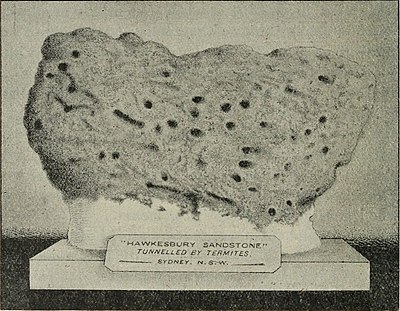about Sydney, in walking over the heights, I was much struck by the curious appearance of the rocks (sandstone), which were in many cases completely honeycombed. As I am always exceedingly inquisitive about holes, I determined to "get to the bottom" of the cause. Upon making enquiries amongst my naturalist friends, I found that many others had noticed it, and it had been the subject of a considerable amount of controversy. Most seemed to favour the hypothesis that it was the work of Wasps, but a few clung to the view that it was done by the Termites. After a considerable amount of labour, I found that the tunnelling was the work of the latter insects, as I found them in situ and at work.[1]
It would seem almost incredible that these little frail-looking creatures should accomplish such work as this, were it not for the fact that their depredations in houses, &c, are so well known. It was only quite recently that the weighty and apparently solid roof of the Australian Museum at Sydney was found to be in places completely honeycombed by these insects. In the course of their work they had actually bored through sheet-lead an eighth of an inch in thickness. Had the roof collapsed there would have resulted irreparable damage. The holes in the before-mentioned sandstone are beautifully uniform in size, are of great symmetry, and are lined in the
- ↑ P.L.S., N.S.W., part iii. p. 418, 1899.

